Abstract
Electromagnetic interference (EMI) shielding effectiveness (SE) of multi-walled carbon nanotubes–polymethyl methacrylate (MWCNT–PMMA) composites prepared by two different techniques was measured. EMI SE up to 40 dB in the frequency range 8.2–12.4 GHz (X-band) was achieved by stacking seven layers of 0.3-mm thick MWCNT–PMMA composite films compared with 30 dB achieved by stacking two layers of 1.1-mm thick MWCNT–PMMA bulk composite. The characteristic EMI SE graphs of the composites and the mechanism of shielding have been discussed. SE in this frequency range is found to be dominated by absorption. The mechanical properties (tensile, flexural strength and modulus) of the composites were found to be comparable or better than the pure polymer. The studies therefore show that the composite can be used as structurally strong EMI shielding material.
Keywords: Carbon nanotubes, Dispersion, Composites, Electrical conductivity, EMI shielding effectiveness
Introduction
Electromagnetic interference (EMI) shielding is very important in today’s world of electronic devices and components [1-4]. EMI shielding in the range of 8.2 to 12.4 GHz (the so-called X-band) is more important for military and commercial applications. Doppler, weather radar, TV picture transmission, and telephone microwave relay systems lie in X-band [5]. The use of carbon nanotubes (CNTs) as a conductive additive for plastics in the electronics, automotive and aerospace sectors with potential uses as EMI shielding materials, coatings for enclosures, ESD composites, antistatic materials, conductive coatings, etc. is emerging as a major application area of CNTs in plastics industry [3,6-9]. Compared to conventional metal-based EMI shielding materials carbon-based conducting polymer composites are becoming attractive because of their light weight, resistance to corrosion, flexibility and processing advantages [4,10]. Amongst the carbon fillers (e.g., graphite, carbon black, or carbon fibers) carbon black is commonly used as conducting filler in polymer composites [1-3,10-12]. The EMI shielding efficiency of a composite material depends on factors such as the filler’s intrinsic conductivity and aspect ratio [13]. At higher filler loadings, composite system suffers from poor mechanical properties due to poor filler–matrix interactions [10]. In using carbon black as filler, a major disadvantage is the high amount of carbon black that is required up to 30–40% to achieve desired conductivity levels, which results in deterioration in the mechanical properties of the polymer [3]. A major advantage of using CNTs is that conductive composites can be formed at low loading of CNTs due to low percolation thresholds [3]. The small diameter, high aspect ratio, high conductivity, and mechanical strength of CNTs make them an excellent option for creating conductive composites for high-performance EMI shielding materials at low filling [13-17]. For effective EMI shielding systems, light weight and mechanically strong materials are more desirable.
Several studies have been reported on the EMI shielding properties of CNT-based polymer composites [4,5,9,13,17-21]. Yang et al. [17] studied the EMI shielding applications of CNT–PS foam composites and obtained a value of about 20 dB at 7 wt% loading. The composites were more reflective than absorptive to electromagnetic radiation. Yang et al. [9] studied the effect of various contents of carbon nanofiber and CNTs within PS matrix on the EMI shielding effectiveness (SE) and found that with the addition of 1 wt% CNTs into a 10 wt% carbon nanofiber–polystyrene composite, a SE value of 20.3 dB was obtained for a 1-mm thick sample. Kim et al. [20] studied the EMI shielding properties of MWCNT–PMMA films in the range 50 MHz−13.5 GHz and reported up to 27 dB SE of MWCNT–PMMA composite films for high CNT loadings of about 40 wt%. Yuen et al. [21] studied the effect of processing conditions on the EMI shielding properties of MWCNT–PMMA composites prepared by in situ polymerization and ex situ fabrication methods. They found that the SE was higher for in situ fabricated composites and also found that the EMI SE of composites prepared by stacking 10 layers of 0.1-mm MWCNT–PMMA films was higher than a single 1-mm thick piece of bulk 4.76 wt% MWCNT–PMMA composite, suggesting the composite stacking process as a better fabrication method. Huang et al. [5] fabricated SWCNT–epoxy composites using long, short, and annealed SWCNT, with different aspect ratios and wall integrities. Very low percolation volumes and 20–30 dB EMI SE were obtained in the X-band range for 15 wt% SWCNT loading. Liu et al. [4] obtained an EMI SE up to 17 dB in 8.2–12.4 GHz band for PU/SWCNT composites with 20 wt% SWCNT loading. It is quite evident that EMI shielding values reported so far for SWCNT- or MWCNT-polymer composites mostly vary between 20 and 30 dB only in the X-band frequency region. Higher values have been reported at frequencies other than the X-band [13,21].
In our earlier studies on MWCNT–PMMA composite films prepared by solvent casting method, we have shown that by dispersing about 10 vol.% MWCNT in PMMA, electrical conductivity of about 1.37 S cm−1 and EMI SE about 18 dB (X-band) could be achieved [18]. The composite showed promise for EMI shielding applications primarily as EMI absorption materials. We report here EMI SE of 40 dB of 10 vol.% MWCNT–PMMA composite. The mechanism of EMI shielding has been investigated by comparing the contribution of reflection and absorption to the total EMI SE. In most of the previous studies on the use of CNTs as EMI shielding materials in polymer composites, no emphasis has been paid on the mechanical properties of the composite material though it remains an important factor. This parameter has also been addressed in this work.
Experimental
Fabrication of MWCNT–PMMA Composite Film
MWCNT used in this study were synthesized by CVD method using toluene as the hydrocarbon source and ferrocene as iron catalyst precursor [18,22,23]. The purity of the as-synthesized MWCNT was about 90% and the uniform diameter was in the range of 60–70 nm, and length up to 50–100 µm.
MWCNT–PMMA composite films were fabricated by solvent casting method (Method A) [18]. As-synthesized MWCNT were ultrasonically dispersed in toluene for 2 h to obtain a stable suspension of CNTs in toluene. The suspension was then mixed with a solution of PMMA in chloroform to obtain a mixture of CNT/PMMA containing 10 vol.% of MWCNT in PMMA. The mixture was again ultrasonicated for 2 h to obtain a uniform dispersion of CNTs in PMMA. Thin polymer film was cast from this solution by pouring the solution into a Teflon spray-coated Petri dish (diameter 4″) and allowing the solvent to evaporate over several days followed by drying in an oven. The resulting film had a thickness of about 0.25–0.30 mm.
Fabrication of MWCNT–PMMA Bulk Composite
MWCNT–PMMA bulk composite was prepared by a two-step method of solvent casting followed by compression molding (Method B) [18]. In this method, solvent-casted films from the aforementioned method were cut into pieces and stacked in a mold (60 mm × 20 mm × 1 mm) and compression molded at 165 °C and 100 kg/cm2 pressure. The resulting composite bar had a thickness of about 1 to 1.1 mm.
Characterization
SEM analysis was carried out to study the dispersion of CNTs in the matrix and also the fracture surface of the composites (film as well as bulk composite) using Model Leo S-440, scanning electron microscope.
The electrical conductivity of the composite films was measured by 4-point contact method [18]. The polymer composite film was cut into rectangular strips of size 70 mm in length and 10 mm in width. Current was supplied using Kiethley 224 programmable current source and the voltage drop was measured using Keithley 197 A auto ranging micro volt DMM.
The EMI SE measurements of the MWCNT–PMMA composites were carried out on an Agilent E8362B Vector Network Analyzer in the frequency range of 8.2 to 12.4 GHz (X-band). The SE of two layers of bulk composite and various layers of composite film (stacked using an insulating adhesive between each layer) was measured using sample specimen size of 21.32 mm × 10.66 mm to fit waveguide sample holder. The thickness of each layer of the film was 0.3 mm and the total thickness of seven layers of stacked composite films was 2.1 mm. The stacked composite films are hereafter referred to as SCF1 (one layer), SCF2 (2 layers), SCF3 (3 layers), SCF4 (4 layers), SCF5 (5 layers), SCF6 (6 layers), and SCF7 (7 layers of composite films). For the bulk composite, the thickness of each layer of bulk composite was 1.1 mm and the total thickness of two layers of bulk composite was 2.2 mm. The stacked bulk composite is hereafter referred to as SCB2 (two layers of bulk composite).
Flexural modulus and flexural strength (ASTM D790) of the bulk composites (size 50 mm × 5 mm × 2 mm) were measured on Instron Tensile Testing Machine Model 4411. Sample span to depth ratio was kept as 20 and cross-head speed was maintained at 0.5 mm/min.
Results and Discussion
EMI Shielding Effectiveness
The EMI SE of a material is defined as the ratio between the incident power (Pi) and outgoing power of an electromagnetic wave (Pt) [12,24]. SE is expressed in decibels (dB) and is given by
When electromagnetic radiation is incident on a shielding material, phenomena such as reflection, absorption, and transmission take place [17]. The total EMI SE (SEtotal) is the summation of the SE due to absorption (SEA), reflection (SER), and multiple reflection (SEM), i.e.,
For a single layer of shielding material, when SEA is ≥10 dB, then SEM → 0 and can be neglected [25].
The transmittanceTis measured from the ratio ofPttoPi, i.e.,
Thus, the SEtotalof shielding material can be written as
Then effective absorbance,Aeffis defined as
with respect to the power of the incident electromagnetic wave inside the shielding material, whereRis the reflectance. Then SE due to reflectance and effective absorbance can be described as
Effect of MWCNT Content on SERand SEAof MWCNT–PMMA Composites
In our earlier studies [18], we reported the effect of MWCNT content on the electrical conductivity and EMI shielding properties of MWCNT–PMMA composite films (single layer) in the X-band. The MWCNT–PMMA nanocomposites with higher MWCNT content exhibited higher conductivity and greater EMI SE. We showed that beyond percolation threshold of 0.5 vol.% for the MWCNT–PMMA composite system, EMI SE increased dramatically with slight increase in electrical conductivity and with increase in CNT vol.%. In fact, EM theory indicates that the EMI SE should increase dramatically once percolation is achieved. The highest EMI SE of about 18 dB was achieved with 10 vol.% MWCNT–PMMA composite. When we further investigated the reflection and absorption components of these composites as a function of CNT content at a particular frequency in the X-band region, it was found that as the MWCNT content increases, both SER and SEA increases. Moreover, SEA increases much faster compared to SER. Figure 1 shows the variation of EMI SE due to reflection and absorption at 12 GHz with increasing MWCNT loadings. The difference between SEA and SER increases as CNT content increases suggesting that the absorption contribution to electromagnetic shielding increases with increase in CNT loading.
Figure 1.
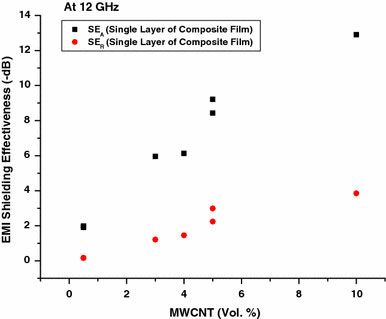
Effect of MWCNT content on SERand SEAof MWCNT–PMMA composite film at 12 GHz
The primary mechanism of EMI shielding is usually a reflection of the electromagnetic radiation incident on the shield, which is a consequence of the interaction of EMI radiation with the free electrons on the surface of the shield [10]. As a result, the shield has to be electrically conducting although a high conductivity is not required. The SER term increases with increase in CNT loading due to increase in conductivity, but the increase is quite gradual due to the moderate increase in conductivity of the films (SER increases from about 0.16 dB at 0.5 vol.% to about 3.85 dB at 10 vol.% loading). Absorption is usually a secondary mechanism of EMI shielding whereby electric dipoles in the shield interact with the electromagnetic fields in the radiation [10]. The increasing difference between SER and SEA with increase in CNT loading may therefore be due to interfacial polarization of PMMA by CNT which increases the absorption component (SEA increases from about 2 dB at 0.5 vol.% to about 13 dB at 10 vol.% loading). The 10 vol.% MWCNT–PMMA film is primarily an EMI absorbing composite material.
Figure 2shows the SEM picture of the 10 vol.% MWCNT–PMMA film prepared by solvent casting method. As evident from the micrograph, there is a uniform dispersion of CNTs in the PMMA matrix suggesting that ultrasonication is effective for dispersing nanotubes in the polymer matrix. A uniform dispersion also ensures uniform conductivity throughout the whole mass of the film, which is important for effective EMI shielding action.
Figure 2.
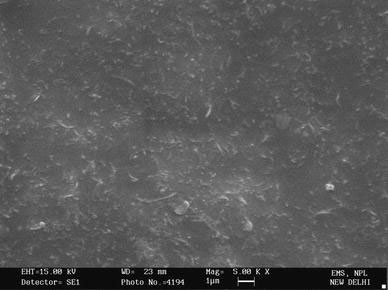
SEM of 10 vol.% MWCNT–PMMA composite film showing MWCNT dispersion in PMMA
EMI SE of 10 vol.% MWCNT–PMMA Composite (Stacked Films and Bulk Composite)
Figure 3 shows the total EMI SE of SCF7 and SCB2 samples. EMI SE up to 40 dB in the frequency range 8.2–12.4 GHz was achieved with SCF7 (thickness 2.1 mm) compared to 30 dB achieved with SCB2 (thickness 2.2 mm). A value of 40 dB achieved for MWCNT–PMMA composite of 2.1 mm thickness by stacking composite films containing 10 vol.% MWCNT is the highest achieved EMI value in the X-band so far. In a similar study Yuen et al. [21] obtained about 25 dB in the 8.2–12.4 GHz frequency range for 10 layers of stacked MWCNT–PMMA composite films and about 20 dB for a single bulk composite of 1-mm thickness at 4.76 wt.% loading. In the present studies, stacking method was used for the composite films and the bulk composite as well. Huang et al. [5] could achieve about 30 dB in the X-band for SWCNT–epoxy composites of 2.0 mm thickness at 15 wt.% loading.
Figure 3.
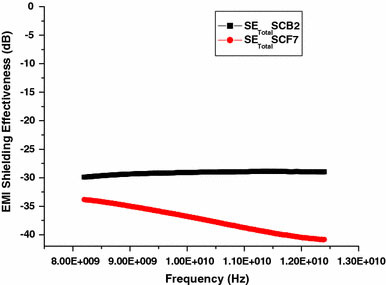
Total EMI shielding effectiveness as a function of frequency measured in the 8.2–12.4 GHz range of SCF7 and SCB2 composites
Effect of Stacking Method on SERand SEAof MWCNT–PMMA Composites
When the total EMI SE (SEtotal) of stacked composite films and bulk composite was further divided into the reflection and absorption components, it was found that SEA was more than SER (Figs. 45). Figure 4 shows that SEtotal of SCF7 ranges between 36 and 41 dB, SEA about 27–34 dB and SER about 6–8 dB. Also, EMI SE in the X-band is mostly independent of the frequency. When SE was further studied layer by layer for composite films, it was found that while SEtotal and SEA increased with increase in number of layers (Figs. 67, respectively) SER was almost same for all layers (Fig. 8). When 10 vol.% MWCNT–PMMA composite is stacked layer by layer, the sample conductivity is not varying since the amount of the conductive filler in the insulating matrix (10 vol. % MWCNT) is the same; however, sample thickness is varying with increase in number of layers. As long as the conductive component is uniform and well dispersed in the polymer matrix, the SE proves in theory and in practice to be a function of conductivity and thickness [12]. In the case of SCF1 to SCF7, SE becomes a function more of thickness than conductivity.
Figure 4.
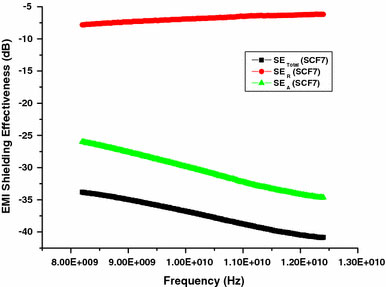
Comparison of SEtotal, SER, and SEAin the 8.2–12.4 GHz range of SCF7 composite
Figure 5.

Comparison of SEtotal, SER, and SEAin the 8.2–12.4 GHz range of SCB2 composite
Figure 6.
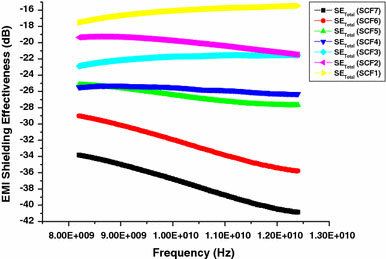
SEtotalas a function of frequency measured in the 8.2–12.4 GHz range of different stacked layers of MWCNT–PMMA composite films
Figure 7.
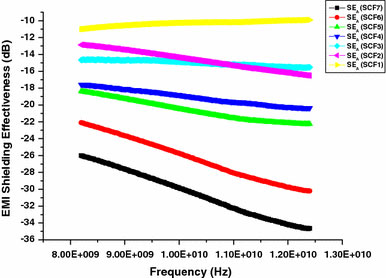
SEAas a function of frequency measured in the 8.2–12.4 GHz range of different stacked layers of MWCNT–PMMA composite films
Figure 8.
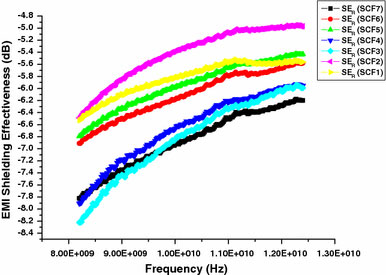
SERas a function of frequency measured in the 8.2–12.4 GHz range of different stacked layers of MWCNT–PMMA composite films
Shielding effectiveness due to reflection increases with increase in filler loading or increase in electrical conductivity as is evident from Fig. 1even though the increase is not very steep. As long as the amount of CNTs is same, the contribution of reflection to total EMI SE will be similar (Fig. 8). This is also evident from the fact that the electrical conductivity of the film and the bulk sample is similar and their EMI SE spectra due to reflection show similar values of about 6–8 dB (Figs. 5,8; Table 1). There is also no effect of composite processing method on SER. The contribution of reflection to the total EMI SE is low due to the moderate conductivity of the composites.
Table 1.
Mechanical, electrical and thermal properties of MWCNT–PMMA composites
| SI. No. | Sample | Density (g/cc) | Tensile strength (MPa)a | Tensile modulus (GPa)a | Flexural strength (MPa) | Flexural modulus (GPa) | Electrical conductivity (S/cm) | EMI (dB) | Thermal stability (°C)a |
|---|---|---|---|---|---|---|---|---|---|
| 1. |
PMMA film |
– |
23.5 |
1.04 |
– |
– |
– |
– |
320 |
| 2. |
PMMA bulk |
1.14–1.15 |
– |
– |
55 |
2.6 |
– |
– |
320 |
| 3. |
10% MWCNT–PMMA film (0.25–0.30 mm) |
– |
23.2 |
1.78 |
– |
– |
1.5 |
18 dB–40 dB in seven layers |
385 |
| 4. | 10% MWCNT–PMMA bulk (1.0–2.0 mm) | 1.18–1.2 | – | – | 64 | 3.5 | 1.6 | 30 dB in two layers | 385 |
a[18]
As evident from Fig. 7, the primary contribution to total EMI SE is absorption rather than reflection in the frequency range studied. This is also consistent with the findings of Kim et al. [20], who also found that the contribution of absorption to total EMI SE for both raw and purified MWCNT–PMMA composites was larger than that of the reflection, suggesting that the systems are promising microwave absorption materials. Our studies show that SE due to absorption increases with increase in filler loading (Fig. 1), but for the same filler loading it also depends upon the thickness of the sample and the method of composite fabrication (Figs. 57). When the total SEA of SCF7 was compared with the total SEA of SCB2, SEA was higher by about 10–11 dB in the first case. Figure 7 shows that SE due to absorption increases with increase in number of layers, i.e., with increase in thickness of the stacked sample. As thickness increases, more radiation is absorbed as there are more CNTs to interact with the radiation in the bulk of the material. A uniform dispersion of CNTs in PMMA results in the formation of an extended conducting network of nanotubes in the polymer matrix. As thickness increases by stacking the composite film layer by layer, the energy is partially lost by multiple reflection phenomena at each interface of film and is partially absorbed by the interconnected nanotubes in the layer. The phenomena of partial absorption, transmission, and multiple reflections are repeated in each subsequent layer resulting in more radiation absorption within the bulk of the sample resulting in higher SE due to absorption. In other words, the combination of the conducting network of nanotubes in the PMMA matrix and the stacking of thin film layers of the network over one another acts as a conducting mesh to intercept electromagnetic radiation, which undergoes reflection and absorption phenomena multiple times within the layers, thereby contributing to the absorption component. Multiple reflections also increase SER but the effect of multiple reflections is more prominent on SEA. The reflection loss (SER) is a function of conductivity [25] and should remain constant with the addition of more layers, as the conductivity of all the layers is same. However, as shown in Fig. 8, SER (at a particular frequency) increases with the increase in the number of layers although the increase is very small. This is due to the contribution from the multiple reflected components to the component reflected from the front face of the first layer. However, the absorption loss takes place each time the radiation passes through the thickness of the shield. Therefore, the multiple reflections lead to corresponding multiple absorptions and account for small increment in reflection. This effect is shown in Fig. 9.
Figure 9.

Effect of stacking method on EMI shielding effectiveness of layered composite
There are fewer chances of occurrence of the multiple reflections phenomena that can contribute to SEAwhen two thick and compact layers are stacked together as in the case of SCB2. Lower SEAin SCB2 (Fig. 5) results in total EMI SE to be lower in the bulk composite due to lesser number of multiple reflections even though the total amount of CNTs and thickness is the same as the SCF7 system.
Characterization of MWCNT–PMMA Composites
Table 1lists the mechanical, electrical, and thermal properties of 10 vol.% MWCNT–PMMA composite prepared by the two different methods. There is no deterioration in the mechanical properties of the composites at 10 vol.% filler loading. In fact, tensile modulus of the film is about 70% higher than the pure polymer. Flexural strength and modulus of the bulk composite are about 16% and 35% higher than the pure polymer, respectively, suggesting a strong composite system. Figures 10and11show SEM of the fracture surfaces after tensile and flexural tests of composite film prepared by Method A and bulk composite prepared by Method B, respectively. Figure 10shows CNTs are well distributed, which was also evident from Fig. 2. Examination of the crack shows some broken nanotubes and crack bridging and some CNT pull-out. It is evident from Fig. 11that there is a uniform dispersion as well as a stronger CNT–PMMA interaction in the bulk composite. The composite film and the bulk composite are thermally more stable by about 65 °C than pure PMMA. Thus, the 10 vol.% MWCNT–PMMA composite system is mechanically stronger, thermally more stable, electrically conducting, and a promising EMI absorption material. Studies are underway to modify the composite fabrication method and optimize the molding process to obtain composites where layered structure of thin films is maintained to permit multiple reflections in the bulk composite, i.e., the structure compactness is reduced while maintaining strong CNT–PMMA interactions of the bulk composite.
Figure 10.
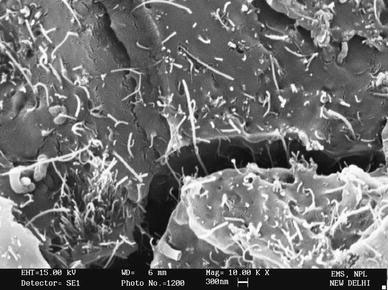
SEM of fracture surface of 10 vol.% MWCNT–PMMA composite film
Figure 11.
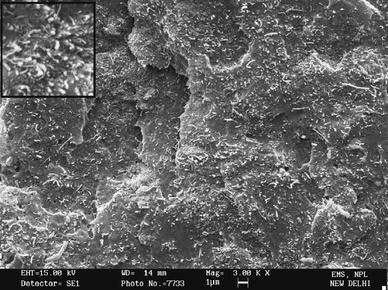
SEM of fracture surface of 10 vol.% MWCNT–PMMA bulk composite
Conclusions
A composite system with desirable mechanical, electrical and thermal properties has been developed, suitable for EMI shielding applications as effective light weight and strong EMI absorption materials. We conclude that stacked layers of thin films or multiple layer composite system of films is more effective than the bulk composite for absorbing EM waves. In the bulk composite, the structure is more compact due to compression molding and the stacked layers are thicker. The EMI SE value of 40 dB of our composite system at 10 vol.% loading of MWCNT in polymer matrix is so far the highest reported in the X-band frequency region.
Acknowledgment
The authors are grateful to Prof. Vikram Kumar, Director NPL, for his permission to publish the research work. One of us (Shailaja Pande) is grateful to DST for providing research grant to carry out the studies under the “Women Scientist Scheme” (Grant no. SR/WOS-A/CS-89/2004).
References
- Luo X, Chung DDL. Carbon. 1996. p. 1293. COI number [1:CAS:528:DyaK28Xmsl2rtbs%3D] [DOI]
- Luo X, Chung DDL. Composites B Eng. 1999. p. 227. [DOI]
- Colbert DT. Plast. 2003. p. 18. COI number [1:CAS:528:DC%2BD3sXksV2gtr8%3D]
- Liu Z, Bai G, Huang Y, Ma Y, Du F, Li F, Guo T, Chen Y. Carbon. 2007. p. 821. COI number [1:CAS:528:DC%2BD2sXhtlWitbw%3D] [DOI]
- Huang Y, Li N, Ma Y, Du F, Li F, He X, Lin X, Gao H, Chen Y. Carbon. 2007. p. 1614. COI number [1:CAS:528:DC%2BD2sXntFKhtL8%3D] [DOI]
- Baughman RH, Zakhidov AA, de Heer WA. Science. 2002. p. 787. COI number [1:CAS:528:DC%2BD38XlvVyhsrw%3D]; Bibcode number [2002Sci...297..787B] [DOI] [PubMed]
- L.M. Sherman, Carbon Nanotubes Lots of Potential—If the Price is Right (Plastics Technology, Gardener Publications, Inc., 2008)
- Breuer O, Sundararaj U. Polym. 2004. p. 630. COI number [1:CAS:528:DC%2BD2cXhtFShu7rJ] [DOI]
- Yang Y, Gupta MC, Dudley KL. Nanotechnology. 2007. p. 345701. [DOI]
- Chung DDL. Carbon. 2001. p. 279. COI number [1:CAS:528:DC%2BD3MXhsFeisr0%3D] [DOI]
- Thostenson ET, Li C, Chou T-W. Compos. 2005. p. 491. COI number [1:CAS:528:DC%2BD2cXhtFeitrvI] [DOI]
- Skotheim TA, Elsenbaumer RL, Reynolds JR. Handbook of Conducting Polymers. CRC Press, New York; 1997. [Google Scholar]
- Li N, Huang Y, Du F, He X, Lin X, Gao H, Ma Y, Li F, Chen Y, Eklund PC. Nano Lett. 2006. p. 1141. COI number [1:CAS:528:DC%2BD28XktFShu7k%3D] [DOI] [PubMed]
- Du J-H, Bai J, Cheng H-M. eXPRESS Polym. 2007. p. 253. COI number [1:CAS:528:DC%2BD2sXmsVyjt7c%3D]; Bibcode number [2007CPL...443..253D] [DOI]
- Ajayan PM, Tour JM. Nature. 2007. p. 1066. COI number [1:CAS:528:DC%2BD2sXmvFKmur8%3D]; Bibcode number [2007Natur.447.1066A] [DOI] [PubMed]
- Grimes CA, Mungle C, Kouzoudis D, Fang S, Eklund PC. Chem. 2000. p. 460. COI number [1:CAS:528:DC%2BD3cXit1Citbk%3D] [DOI]
- Yang Y, Gupta MC, Dudley KL, Lawrence RW. Nano Lett. 2005. p. 2131. COI number [1:CAS:528:DC%2BD2MXhtVeht73L] [DOI] [PubMed]
- Mathur RB, Pande S, Singh BP, Dhami TL. Polym. 2008. p. 717. COI number [1:CAS:528:DC%2BD1cXnvFWntLw%3D] [DOI]
- Yang Y, Gupta MC, Dudley KL, Lawrence RW. J. 2005. p. 927. COI number [1:CAS:528:DC%2BD2MXltVamsbs%3D] [DOI] [PubMed]
- Kim HM, Kim K, Lee CY, Joo J, Cho SJ, Yoon HS, Pejakovic DA, Yoo JW, Epstein AJ. Appl. 2004. p. 589. COI number [1:CAS:528:DC%2BD2cXmslaqsQ%3D%3D]; Bibcode number [2004ApPhL..84..589K] [DOI]
- Yuen S-M, Ma C-CM, Chuang C-Y, Yu K-C, Wu S-Y, Yang C-C, Wei M-H. Compos. 2008. p. 963. COI number [1:CAS:528:DC%2BD1cXhsFWlsrY%3D] [DOI]
- S.Pande, R.B. Mathur, B.P. Singh, T.L. Dhami, Polym. Compos (2008). doi: 10.1002/pc.20696.
- Mathur RB, Chatterjee S, Singh BP. Compos. 2008. p. 1608. COI number [1:CAS:528:DC%2BD1cXlslKitLY%3D] [DOI]
- Singh K, Ohlan A, Saini P, Dhawan Polym SK. Adv. 2008. p. 229. COI number [1:CAS:528:DC%2BD1cXltVOlsLg%3D] [DOI]
- P. Saini, V. Choudhary, B.P. Singh, R.B. Mathur, S.K. Dhawan, Mater. Chem. Phys. (2008). doi: 10.1016/j.matchemphys.2008.08.065.


